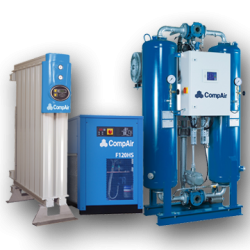Air Dryers – Making the right choice
January 10, 2020 10:38 am
An important part of many compressed air systems is the compressed air dryer. As the name implies, air dryers are used to remove moisture from the air, resulting in dryer air. This is needed to protect tools, pipework and machinery from water and the potential for rust. All air has some moisture in it, an air dryer is needed because while the air that is sucked into the system is compressed, the water is not, leaving a much higher percentage of water to air, and consequently a higher possibility of it causing damage.
The three main types of compressed air dryers are refrigerated, desiccant, and membrane. It is important to understand how each drying technology works to learn which is best for your application.
Refrigerated dryers: These are the most common type of dryer and use a small refrigerator to cool the air to around 3 degrees Celsius. The water in the air will then condense and can be removed through a condensate trap. The air can then be reheated to ambient temperature and as long as it doesn’t cool to below 3 degrees will not collect more water. These dryers have a relatively high “Dew Point”, the temperature at which cooled air becomes saturated with water vapor. This means that refrigerated dryers are good at providing clean general-purpose air economically for most industrial applications but are not often used in very water sensitive environments.
Desiccant dryers: Air flows over a bed of hygroscopic material, something that attracts moisture such as silica gel or activated alumina. The water will ‘stick’ to the surface of the desiccant, resulting in drier air. The desiccant material will regenerate automatically within the dryer by blowing dry, hot air through the desiccant to remove the water. The desiccant will now remove more water from the air. Desiccant dryers, which can also be known as Adsorption dryers can reach much lower dew points than refrigerated dryers, down to -70 degrees Celsius. These are often used as secondary dryers for applications requiring air with a lower dew point where a refrigerated dryer is being used as the primary source of dried air.
Membrane dryers: The compressed air is passed over a membrane that attracts water vapour. The water vapour builds up on the membrane and migrates through to the opposite side of the membrane which is at a lower pressure. A dry cover gas is flowed across the low-pressure side absorbing the water on the membrane and discharging it from the dryer. Membrane air dryers are designed to operate continuously, are quiet and reliable. They also require no electricity making them an energy efficient option. They are often used in specialist manufacturing, laboratories and medical facilities where relatively small amounts of compressed air are needed. As they are relatively delicate pieces of machinery, they are not often used in general manufacturing environments.
Selecting the most appropriate dryer for your system is a process of understanding your requirements for compressed air. While damage caused by wet air can result in maintenance downtime and lost production, drying the entire compressed air supply in a factory to dew points below what is needed within your environment will be energy inefficient and costly. If you can review your compressed air requirements by application and provide appropriately dry air for each process, then you will arrive at the best compromise for your facility. Harrier Pneumatics are always pleased to advise on your air-drying requirements. Get in touch to talk to one of our engineers.
Categorised in: air dryers, Blowers, compressor sales, compressor services, Compressors, Maintenance
This post was written by Harrier Pneumatics





